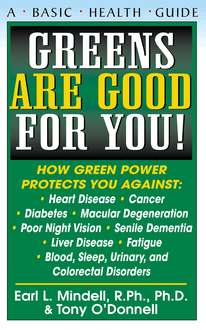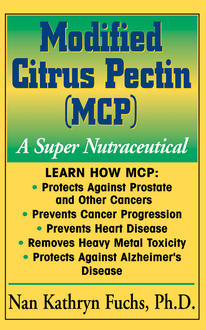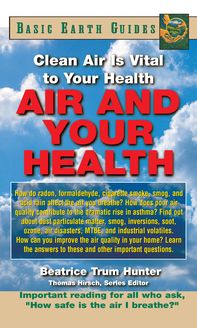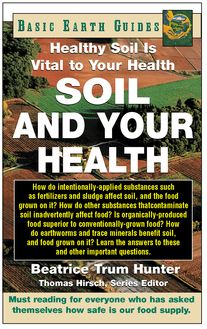Soil and Your Health , livre ebook
56
pages
English
Ebooks
2004
Vous pourrez modifier la taille du texte de cet ouvrage
Obtenez un accès à la bibliothèque pour le consulter en ligne En savoir plus
Découvre YouScribe en t'inscrivant gratuitement
Découvre YouScribe en t'inscrivant gratuitement
56
pages
English
Ebooks
2004
Vous pourrez modifier la taille du texte de cet ouvrage
Obtenez un accès à la bibliothèque pour le consulter en ligne En savoir plus
Publié par
Date de parution
01 janvier 2004
Nombre de lectures
2
EAN13
9781591206392
Langue
English
Poids de l'ouvrage
2 Mo
Publié par
Date de parution
01 janvier 2004
Nombre de lectures
2
EAN13
9781591206392
Langue
English
Poids de l'ouvrage
2 Mo
SOIL
AND YOUR
HEALTH
Healthy Soil Is
Vital to Your Health
Beatrice Trum Hunter
Thomas Hirsch, Series Editor
The information contained in this book is based upon the research and personal and professional experiences of the author. It is not intended as a substitute for consulting with your physician or other healthcare provider. Any attempt to diagnose and treat an illness should be done under the direction of a healthcare professional.
The publisher does not advocate the use of any particular healthcare protocol but believes the information in this book should be available to the public. The publisher and author are not responsible for any adverse effects or consequences resulting from the use of the suggestions, preparations, or procedures discussed in this book. Should the reader have any questions concerning the appropriateness of any procedures or preparations mentioned, the author and the publisher strongly suggest consulting a professional healthcare advisor.
Series Editor: Thomas Hirsch • Typesetter: Gary A. Rosenberg
Series Cover Designer: Mike Stromberg
Basic Health Publications, Inc.
8200 Boulevard East • North Bergen, NJ 07047 • 1-800-575-8890
Library of Congress Cataloging-in-Publication Data
Hunter, Beatrice Trum.
Soil and your health : healthy soil is vital to your health / by Beatrice Trum Hunter.
p. ; cm.
Includes bibliographical references and index.
ISBN 978-1-59120-639-2
ISBN 1-59120-062-8
1. Soil pollution. 2. Soil–Health aspects. 3. Environmental health.
[DNLM: 1. Soil—Popular Works. 2. Soil Pollutants–adverse effects—Popular Works. 3. Fertilizers–adverse effects—Popular Works. WA 785 H295s 2004] I. Title.
RA571.H86 2004
616.9'8—dc22
2003022145
Copyright © 2004 by Beatrice Trum Hunter
All rights reserved. No part of this publication may be reproduced, stored in a retrieval system, or transmitted, in any form or by any means, electronic, mechanical, photocopying, recording, or otherwise, without the prior written consent of the copyright owner.
Printed in the United States of America
10 9 8 7 6 5 4 3 2 1
C ONTENTS
Editor’s Note
Introduction: Healthy Soil Builds Healthy Bodies
1. Soil and Your Health
2. Conserving the Soil
3. Conservation Tillage
4. Earthworms: Nature’s Soil Builders
5. Building Good Soil
6. Soil Quality: Organic vs. Conventional Farming
7. Soil Fertility and Weeds
8. Consuming Soil
9. Toxic Trace Minerals in Soil
10. Sludge: An Inappropriate Soil Fertilizer
11. Soil Contamination with Drugs
12. Losing Soil in Global Dust Storms
13. Bioremediation of Contaminated Soil
Main Sources
Additional Readings
E DITOR’S N OTE
Dear Reader:
Welcome to the Basic Earth Guide series! As you know, the natural world is becoming degraded at an alarming rate. Hardly a day passes without a new headline about the effects of global warming, species loss, and other distressing environmental news. Incredibly, during every second of every day, more than an acre of the world’s precious and irreplaceable rain forests is being lost. The depletion of beneficial oxygen-producing plants, which are part of the rain forest’s ecosystem, makes us vulnerable to the 6,000 metric tons (13,230,000 pounds) of carbon dioxide emitted into the atmosphere each year. The subtraction of oxygen and the addition of carbon dioxide adversely affects everyone’s health and quality of life. This example is but one of a number of environmental problems that beset us. Residues of toxic pollutants, ranging from pesticides in our food; chemicals in our homes such as cleaning agents, sealants, solvents, formaldehyde, and lead-contaminated paint; gas leakages from cook-stoves; outgassings from plastics; fragrances in consumer products; to a host of other volatile substances, both indoors and outdoors, affect our health. Over time, chronic exposure to these substances compromise our immune systems and contribute to various illnesses and health problems. Some experts caution that we have only one generation of time to reverse conditions in our polluted environment, or we shall experience irreversible damage. Many people feel that the problems are on such a vast scale, are so complex and overwhelming, that individual efforts are futile. They are wrong.
The Basic Earth Guide series demonstrates that you, as an individual, can take meaningful action. Each Basic Earth Guide sets forth a group of ecological problems you face daily, and provides alternative, environmentally sound, practical solutions. Each Basic Earth Guide provides the best researched ideas and up-to-date information to help you make ecologically sounder decisions in your day-to-day living. The Guides are written simply and lucidly for easy comprehension. Among topics covered are renewable energy, ‘green’ building and retrofitting, home care and maintenance, personal care products, and ecological lifestyles.
We hope that, as a reader of Basic Earth Guides , you will become better informed and motivated to improve the environmental quality of your life, as well as the lives of those around you. There can be a new world out there! We thank you for allowing us to introduce it to you.
Green regards,
Thomas Hirsch, series editor
P.S. Do let us know of additional subjects that interest you, for us to consider as topics for future Basic Earth Guides. You can reach us at ngoldfind@basicmediagroup.com .
H EALTHY S OIL B UILDS H EALTHY B ODIES
T o the average viewer, soil may appear dark or light; dry, moist, or muddy; but certainly inert. Yet, invisible to the naked eye are the many ongoing functions that make soil a virtual nutrition factory, teeming with life. Mixed with water, soil delivers vitamins, minerals, and other beneficial substances to foods grown or raised on it. These products give us the nutrients we need to be healthy. Yet, today’s conventional agricultural practices ignore the importance of soil health and its contribution to human health. The routine application of toxic pesticides, herbicides, and chemical fertilizers and other widespread practices, such as the use of sludge, are weakening the health and nutritional vitality of our soil and food.
We may regard soil as unalterable and able to absorb limitless amounts of toxins. Not so. In the twentieth century, the millennial-old closed system of agriculture was changed radically by the application of chemicals to fertilize soil and others to inhibit the proliferation of destructive pests. Farmers abandoned their traditional use of animal and crop wastes to maintain soil fertility in favor of these new chemicals. Soil began to lose its integrity and capacity to regenerate organic matter faster than it was being lost. Precious topsoil was lost, and widespread soil erosion developed. The experience of the dust bowl in the early twentieth century, and the more recent global dust storms, are the end result. As farmers embraced these new practices, some of their disturbing consequences largely went unnoticed. Now we can trace living microbes, viruses, toxic metals, radioactive byproducts, and dried fecal matter carried thousands of miles from their origin, and deposited elsewhere. Scientists have been able to identify soil and its contaminants as one cause of the worldwide rise in health problems such as asthma and respiratory illnesses.
Reforming our current unwise farming practices is a formidable task. Farming methods must be changed so that once more our soil will provide crops and livestock with sustenance for human health. Soil and Your Health presents the issues concisely and offers practical information about how we can solve the problems. The more we appreciate the worth of healthy soil, the better we will be able to achieve a healthy and nutritious food supply for ourselves and for future generations.
S OIL AND Y OUR H EALTH
I n the Book of Job, one is advised to “Speak to the earth, it shall teach thee.” What can we learn from soil? What does it teach us?
First, we must examine it. Unfortunately, some people regard soil only as “dirt,” with no recognition that it sustains life.
In examining soil, take a handful and crumble it. Is it hard-packed and heavy? Or is it spongy and friable? Is it light or dark colored? Its physical appearance gives some indication of its qualities. Then, dig some soil with a spade. Do you find sweet-smelling humus on top? Or is it light-colored and sandy? Or is it like clay? Are earthworms wriggling in it?
The physical appearance of soil reveals some of its characteristics. Its structure, texture, consistency, porosity, color, and other features indicate some essential properties. Chemical analysis yields more information.
Soil varies considerably from time to time, from place to place, and even from field to field. Soil formation is dynamic, a living process. Gardeners and farmers can vary the proportions of organic and mineral matter, water, and air, and change the composition of their soil. Even if soil is poor, with good fertilizers, soil can be improved greatly, and become far more fertile.
In nature’s original settings of prairie grasslands and virgin forests, organic material was supplied constantly by the native flora and fauna supported by the soil. Beneficial organisms in the soil continually converted dying substances into humus and maintained a permanent state of soil fertility.
In the agricultural setting, however, the flora and fauna are removed from soil with each new planting. To maintain soil fertility, it is necessary to supply raw organic materials from which humus can be made in the soil itself, or to develop humus in compost, outside the soil and apply the compost to the soil.
When a closed system of agriculture returns all wastes to the land, high levels of fertility can be sustained. However, the agricultural revolution, with the introduction of chemical fertilizers and pesticides, wrought radical changes to our farm land







